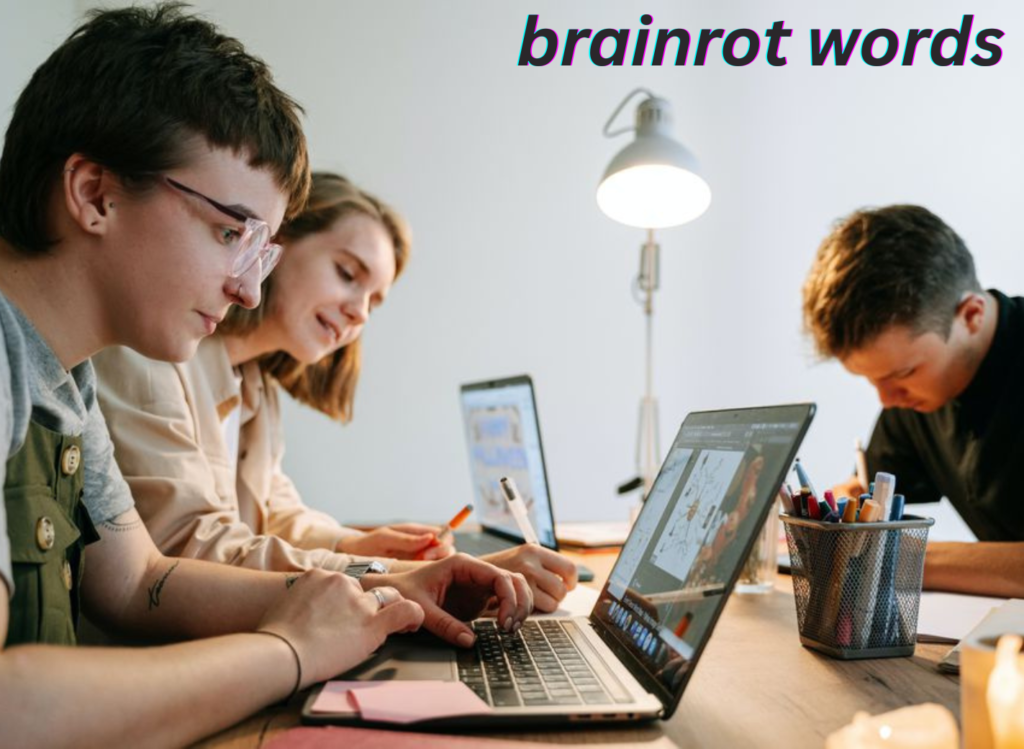In the fast-paced world of digital communication, certain words seem to infiltrate our everyday language, spreading like wildfire across social media platforms and online communities. These words, often referred to as brainrot words quickly go from trendy expressions to overused, sometimes meaningless phrases that leave many wondering about their true significance. But what exactly are brainrot words, and why do they spread so rapidly across the internet?
What are Brainrot Words
Brainrot words are expressions or phrases that gain immense popularity in digital spaces, often becoming catchphrases that seem to pop up in almost every post, comment, or tweet. Initially, these words might carry some novelty, humor, or creativity, but over time, they become so overused that they lose their original charm and can start to feel grating or even meaningless. These words often thrive in environments like social media platforms, memes, or group chats, where trends and language shifts happen at lightning speed.
The essence of brainrot words lies in their ability to infect online communities. They’re used frequently, almost compulsively, by members of those communities, which helps them gain viral traction. Just as a catchy tune or viral meme takes on a life of its own, brainrot words can quickly transcend their original contexts, spreading far beyond the platform or community in which they originated. However, the real question is: why are these words so addictively used, and what impact does their proliferation have on communication?
The Rise of Brainrot Words in the Digital Era
One of the most significant factors contributing to the rise of brainrot words is the role of social media. Platforms like TikTok, Twitter, and Reddit play an integral part in shaping the language we use online. Words and phrases spread quickly across these platforms, often gaining momentum through viral trends and memes. For example, a word that starts as a joke in a TikTok video can quickly become a staple phrase in the daily lexicon of millions of users.
Social media’s algorithmic nature also plays a part in word propagation. Algorithms are designed to boost popular content, which means that certain posts, especially those using trending words, get more exposure. This exposure accelerates the word’s spread, as people begin using it to join in on the trend or feel a sense of connection with others. As people constantly interact with this content, they often adopt the same language, repeating the words in their own posts, comments, and chats.
Furthermore, influencers and content creators have an undeniable influence on the spread of brainrot words. These individuals have large followings and can introduce new words to their audience in a way that feels organic and authentic. Once a popular figure starts using a phrase, their followers are likely to adopt it, creating a ripple effect that expands the reach of the word. This is particularly true for viral content creators who are at the forefront of internet culture and trends.
Psychological and Linguistic Impacts of Brainrot Words
At the heart of brainrot words lies a complex psychological and linguistic phenomenon. The addiction to certain words is partly driven by our desire for social connection. When we use words that are trending or popular in certain circles, we feel a sense of belonging. It’s a way to participate in a larger conversation and to signal to others that we are in tune with current cultural trends. Over time, this can lead to the compulsive use of certain words, even when they no longer carry any meaningful or substantial value.
Linguistically, the overuse of brainrot words can have a profound impact on how we communicate. While these words might initially serve to enhance or add humor to a conversation, their frequent usage can lead to a breakdown in clarity. When everyone uses the same words in the same way, they begin to lose their power. The very thing that made these words appealing in the first place — their novelty and punch — begins to dissipate as more and more people use them, often without fully understanding their original intent or meaning.
Additionally, the overuse of brainrot words can result in what is often referred to as the “dilution” of language. When a word is used excessively, it starts to lose its significance. For example, words like “lit” or “slay,” once powerful in their original contexts, have become so saturated that they now serve more as filler words than meaningful descriptors. While this phenomenon might seem harmless, it raises important questions about the way we communicate in a digital age. Are we losing the ability to use language creatively and meaningfully, or are we simply adapting to new forms of expression?
Examples of Popular Brainrot Words
To better understand the impact of brainrot words, let’s explore some of the most popular examples. Words like “slay,” “sus,” and “lit” have become almost ubiquitous in digital spaces, especially on platforms like TikTok and Twitter. “Slay,” originally used to describe someone excelling or performing at a high level, has evolved into a way to express admiration or approval, often in a tongue-in-cheek manner. Similarly, “sus,” short for “suspicious,” has taken on a life of its own in gaming communities, eventually seeping into mainstream culture through memes and viral trends.
These words, while fun at first, begin to lose their impact once they are used too often. As they become more widespread, their meaning shifts, sometimes to the point where they lose all connection to their original definitions. Take the word “lit” as an example. Once used to describe something exciting or excellent, it now feels almost empty, used so frequently in various contexts that it has lost its original flair.
Interestingly, some words seem to evolve over time. For example, the phrase “I can’t even” started as a humorous expression of being overwhelmed or speechless, but has now become a staple in internet language, often used in an exaggerated or sarcastic manner. Words like these tend to go through cycles, becoming popular, losing their novelty, and then either fading into obscurity or transforming into something entirely new.
The Cultural Significance of Brainrot Words

Brainrot words are more than just fleeting trends; they are deeply tied to internet subcultures and group identity. The creation and adoption of these words often stem from specific online communities. For instance, the gaming world is full of unique slang terms and phrases that are exclusive to gamers, creating a sense of in-group language that helps solidify their shared identity. Similarly, meme culture has birthed an entire lexicon of terms that are understood and used primarily by those who are active participants in the meme ecosystem.
Moreover, brainrot words can transition from being seen as annoying or overused to becoming iconic or nostalgic. When a word first gains traction, it can be jarring or irritating to those who are not part of the community that uses it. However, over time, these words can evolve into cultural symbols, taking on a life of their own. They might even spark feelings of nostalgia for those who remember their heyday, similar to how fashion trends from the past sometimes experience a revival.
The cultural significance of these words cannot be underestimated, as they provide a way for people to communicate in a more playful, creative, and sometimes ironic manner. They reflect the fast-paced, ever-evolving nature of internet culture, where new trends and languages emerge almost daily. Brainrot words are an extension of the dynamic way in which language is constantly shaped by the digital environment.
Conclusion
Brainrot words, while often seen as a fleeting aspect of digital culture, reveal a deeper truth about the evolution of language in the internet age. From their rise in social media platforms to their psychological and linguistic impacts, these words offer insight into how we communicate, connect, and create meaning in online spaces. While the overuse of brainrot words can lead to their dilution and eventual loss of significance, they also highlight the playful and adaptive nature of human language. As we look to the future, it’s likely that brainrot words will continue to emerge and fade as part of the ever-changing landscape of digital communication. However, the key takeaway is this: while these words may come and go, they represent the power of language to shape and reflect cultural movements, offering a glimpse into the ways we express ourselves in a rapidly evolving world.
FAQs
What are brainrot words?
Brainrot words are overused phrases or expressions that lose their original meaning due to excessive repetition, often becoming an addictive part of online language and culture.
How do brainrot words affect communication?
They can dilute language, reducing clarity and meaning. Overuse of these words can lead to communication becoming repetitive and less impactful.
Are brainrot words a sign of laziness in language?
Not necessarily. While brainrot words might reflect a tendency to lean on familiar phrases, they also represent the dynamic and evolving nature of language in digital culture.
Can brainrot words be reclaimed or revived in meaningful ways?
Yes, some brainrot words evolve over time and can regain significance when used in new or creative contexts. Their transformation can also highlight changes in cultural trends.
Why do we continue using brainrot words despite their overuse?
These words create a sense of connection within online communities, and their repetitive nature can make them feel comforting or even addictive to those who are immersed in the trends they represent.
You May Also Read: https://ventsworlds.com/fau-basketball/

